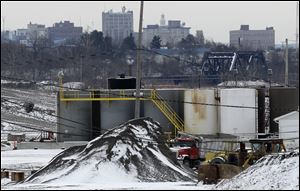
State blames earthquakes on well
Ohio says wastewater from drilling reached unmapped fault
3/10/2012
An injection well owned by Northstar Disposal Services is within miles of downtown Youngstown.
YOUNGSTOWN -- Recent earthquakes along a geologic fault line in eastern Ohio were caused by a deep-injection well used to dispose of wastewater from Marcellus Shale gas drilling, a state investigation has revealed.
The investigation by the Ohio Department of Natural Resources linked the earthquakes to "coincidental events," including the drilling and operation since December, 2010, of the 9,184-foot-deep Northstar No. 1 disposal well owned by D&L Energy.
The well, also referred to by D&L Energy as the "Ohio Works," is five miles northwest of Youngstown. It received most of the brine and fracking wastewater it was injecting underground from Marcellus Shale drilling operations in Pennsylvania.
The natural resources department's 20-page preliminary investigation report released Friday based its findings on evidence from seismic monitors, the locations of the epicenters of 12 minor earthquakes within one mile of the disposal well, and the discovery of a heretofore unknown fault in the underlying bedrock.
"We made the determination that, while it's difficult to induce seismic activity, the depth of this well reached a previously unmapped fault, and there is a likelihood it lubricated the fault resulting in seismic activity," said Carlo LoParo, a natural resources department spokesman.
The earthquakes registered magnitudes of 2.7 to 4.0, rattling dishes in homes but causing no structural damage. A 4.0-magnitude earthquake has a seismic energy yield equivalent to detonating 15 metric tons of dynamite or a small atomic bomb.
The first earthquakes occurred three months after the high-pressure injection of wastewater began.
Several quakes occurred in December, 2011, with the last and most powerful on New Year's Eve, less than 24 hours after state regulators asked the company to shut down the well.
According to the report's summary, although there is a history of seismic activity in Ohio before 2011, there was no recorded earthquake activity with epicenters in the Youngstown area.
No fault line previously had been mapped within the boundaries of Youngstown or Mahoning County.
"The report's findings are not surprising. We thought all along that it was very likely the two were related," said Won-Young Kim, a professor of seismology, geology, and tectonophysics at Columbia University's Lamont-Doherty Earth Observatory in New York, one of the earthquake experts Ohio hired last year.
"It's very rare that injection wells induce seismic activity, but it happens sometimes," Mr. Kim said. "When fluids encounter fault zones underground it can trigger quakes. The difficulty comes because we don't know the subsurface geology very well."
Youngstown-based D&L Energy released a statement Friday critical of the natural resources department for making conclusions without conducting any new tests at the Northstar well or waiting for the results of a company testing-and-research study that is under way at the site.
"It is unfortunate," the D&L statement said, "that ODNR pre-empted a thorough search for information, opting instead for a politically expedient preliminary report that sacrifices true understanding for haste."
As a result of the earthquakes, Ohio halted injection of wastewater in the Northstar well and development of four new wastewater-injection wells within five miles of it.
The state also will implement new injection-well rules that ban injection into Precambrian "basement rock," require state-of-the-art monitoring of well pressure and injection volumes, and require an electronic tracking system for wastewater from drilling that enters the state.
Terry Fleming, executive director of the Ohio Petroleum Council, noted that the investigation report acknowledges that "properly located injection wells do not cause earthquakes," but he also said the council supports the state's investigation and the proposed regulatory changes.
Susie Beiersdorfer, a geology instructor at Ohio State University and coordinator of Frackfree Mahoning Valley, a group opposed to shale gas drilling in eastern Ohio, said the organization favors a moratorium on new deep-injection well drilling until more can be learned about the state's underlying geology.
"The state wants to restart the permitting process on these injection wells, but I think we need more information first about the risks to public health and safety," said Ms. Beiersdorfer, who lives near Youngstown and said she felt several of the earthquakes.
Since 1983, when Ohio started its deep-injection well program, 202 million barrels, or about 10 billion gallons, of oil and gas field waste fluids and brine have been disposed of in 177 Class II deep-injection wells.
Pennsylvania has six injection wells.
Kevin Sunday, a Pennsylvania Department of Environmental Protection spokesman, said the department will review the Ohio findings, but he noted that, unlike Ohio, Pennsylvania gives the U.S. Environmental Protection Agency primary permitting responsibility for wastewater-injection wells.
The Block News Alliance consists of The Blade and the Pittsburgh Post-Gazette. Don Hopey is a reporter for the Post-Gazette.
Contact Don Hopey at: dhopey@post-gazette.com or 412-263-1983.